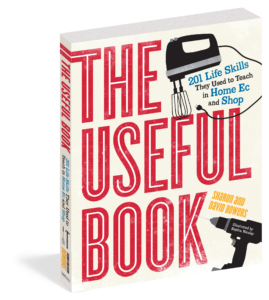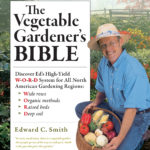Do like the squirrels and stock up for winter with this guide to weekly shopping and long-term planning from Sharon and David Bowers’ The Useful Book.
Planning grocery purchases in advance helps save you money, minimizes trips to the store, and guarantees that you will always have staples on hand. Shop with menus in mind, and you’ll never find yourself desperate for fresh cilantro in the middle of chopping tomatoes for your famous salsa.

1. Set the standard.
Taking the time for this step will pay off again and again. Head to your favorite supermarkets and big-box stores—wherever you like to shop—with a pen and paper. Starting at one end of the store (I suggest the dairy case), write down the prices for the items you usually buy or are likely to buy. Don’t skip any aisles—this list is your shopping bible, and you want it to be comprehensive. At home, write a multipage checklist for each store, grouping the items by type (produce, meat, etc.) or by aisle number. If you do this in your regular stores, you’ll quickly figure out that some places are ideal to stock up on, say, olive oil, flour, and sugar, whereas others are less expensive if you’re just running in for a gallon of milk and some eggs.
2. Collect coupons.
Keep a manila envelope tacked to a bulletin board or a divided folder in a drawer. Before hitting the supermarket, go through your coupon stash and compare it with your list. Saving a few pennies on items you don’t need or won’t eat isn’t smart, but reducing the bill on shelf-stable staples or needed weekly menu ingredients makes sense (and cents!).
3. Hit the books.
Before your weekly shopping trip, look through your cookbooks and recipes, and plan what meals you’d like that week, along with big-batch freezables such as chili, soups, stews, and casseroles like lasagna. This curbs impulse buying and helps prevent overbuying and waste.
4. Cross-reference.
If you know you need fresh parsley for chicken soup, and bunches are twice as big as you’ll need, plan to also make tabbouleh or chimichurri sauce. Then check those recipes and list their ingredients so you’re not caught short.
5. Check your supply of perishables.
With fresh staples such as milk, eggs, bread, and cheese and the addition of pantry items such as olive oil, dried pasta, canned tomatoes, canned fish, jarred olives, and jams on hand, you’ll be able to make a quick, hearty meal, any time of day.
 About the Book:
About the Book:
A modern and energetically designed encyclopedia of DIY with everything you need to know to roll up your sleeves and cook it, build it, sew it, clean it, or repair it yourself. In other words, everything you would have learned from your shop and home ec teachers, if you’d had them.
The Useful Book features 138 practical projects and how-tos, with step-by-step instructions and illustrations, relevant charts, sidebars, lists, and handy toolboxes. There’s a kitchen crash course, including the must-haves for a well-stocked pantry; how to boil an egg (and peel it frustration-free); how to grill, steam, sauté, and roast vegetables. There’s Sewing 101, plus how to fold a fitted sheet, tie a tie, mop a floor, make a bed, and set the table for a formal dinner.
Next up: a 21st-century shop class. The tools that everyone should have, and dozens of cool projects that teach fundamental techniques. Practice measuring, cutting, and nailing by building a birdhouse. Make a bookshelf or a riveted metal picture frame. Plus: do-it-yourself plumbing; car repair basics; and home maintenance, from priming and painting to refinishing wood floors.
Buy the Book
Amazon | B&N | Indiebound | Workman





No Comments